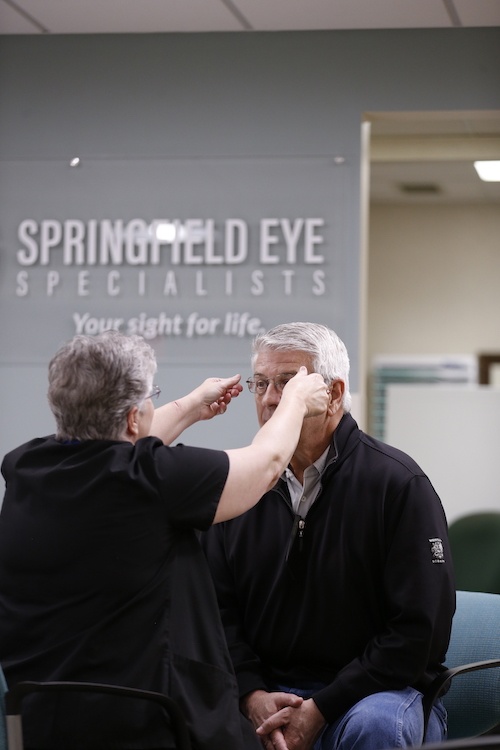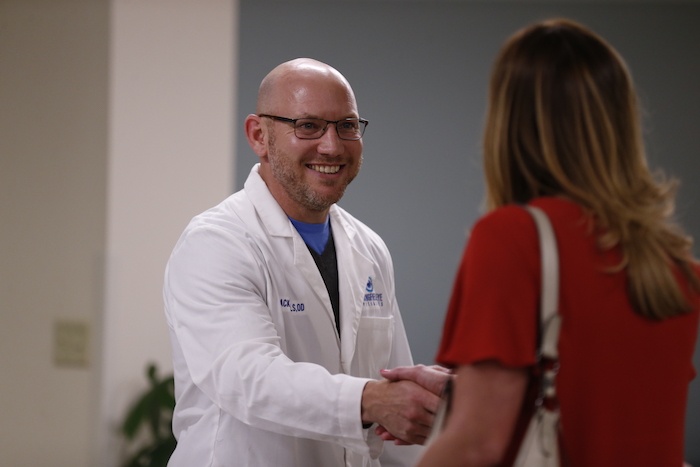Services We Offer
Preventive Eye Care | Treatment | Retail
First-Time Patient?
Give us a call today and we would be happy to schedule your new-patient appointment!
Adult Eye Care
Adults aged 19-40 should have an eye exam at least once every two years. If you have vision insurance, use it! It can save you from future strain… physically and financially.
Macular Degeneration
Macular degeneration causes loss in the center of the field of vision. Blurred vision is a key symptom.
Dry Eye Solutions
The eye may become dry, red, and inflamed. The main symptoms are discomfort and sensitivity to light. Prescription and lubricating eye drops can reduce dryness.
Children’s Eye Care
Keep your kid’s futures bright with regular exams and checkups. We offer a selection of children’s eye wear of all colors that include fashionable, soft and flexible, character-themed and sport.
Glaucoma
With all types of Glaucoma, the nerve connecting the eye to the brain is damaged, usually due to high eye pressure. Treatment includes eye drops, medications, and surgery.
Diabetic Retinopathy
This is a complication of diabetes that affects the eyes. Springfield Eye Specialists can help you diagnose, treat, and manage this condition.

Eye Exams
Adults aged 19-40 should have an eye exam at least once every two years; ages younger and older we recommend once a year. If you have vision insurance, use it! It can save you from future strain…physically and financially.
Treatment Solutions
Whether surgical options are elective or a necessity. Springfield Eye Specialitists are highly trained in the medical field and will be able to guide you through the process. Refractive, Laser, Lasik, Cataract, just to name a few, are all fields we can create a care plan for and will refer you to the most skilled surgeons for your case and will help you feel comfortable throughout the process.
More Information on Services We Offer
If you are needing additional information on some of the services that we offer, please take a look at the information below.
Glaucoma
A healthy optic nerve is necessary for good vision. Glaucoma is a group of diseases that damage the eye’s optic nerve and can result in vision loss or blindness. Though the causes of glaucoma are not completely understood, the damage to your optic nerve is related to increased pressure in your eye from buildup from the aqueous humor, the watery fluid that is naturally present in your eyeball. Glaucoma is hard to detect without an eye care professional, so come see us and we’ll develop a plan and determine if daily medication is your best practice. There is no cure for glaucoma, and vision lost cannot be restored, so proper checkups are essential.
Natural ways of helping reduce eye pressure and reducing your chance at glaucoma are to take animal-based omega-3 fat supplements, getting loads of lutein and zeaxanthin, avoiding trans fats and eating dark-colored berries. But overall we recommend regular checkups to be your best line of defense.
Diabetic Retinopathy
If you have diabetes, your body’s high blood sugar levels can cause damage to blood vessels in the retina. These blood vessels can begin to swell and leak, sometimes resulting in blood passing through. Decreased blood flow and sometimes abnormal growth of new vessels growing on the retina, can create loss of vision.
There are two main stages of diabetic eye disease.
NPDR (non-proliferative diabetic retinopathy) With NPDR your vision will be blurry due to decreased blood flow through your blood vessels or even closed off vessels leading to macular ischemia. When this happens, blood cannot reach the macula and sometimes exudates (small particles) can form in the retina. PDR (proliferative diabetic retinopathy) PDR is the more advanced stage of diabetic eye disease often resulting in complete loss of vision or floaters. Neovascularization happens when the retina starts growing new blood vessels that often bleed into the vitreous, if they bleed a little you will see floaters if they bleed a lot you might block all vision.
What to look for if you think you have diabetic eye disease? Patients are generally asymptomatic, and in more advanced stages you may experience symptoms that include floaters, distortion and/or blurred vision. Microaneurysms are the earliest clinical sign of diabetic retinopathy.
We all know that we need to take care of our bodies, for optimal health. The best way to help reduce your risk of getting diabetic retinopathy, or to help keep the symptoms from getting worse if you already have it, are by keeping your blood sugar levels as recommended for your age and body type and by keeping your blood pressure and cholesterol levels under control. Often these measures are accompanied by the need to take medication.
Dry Eyes
Dry Eye Syndrome is a very common problem that consists of ocular irritation, burning, itching, pain, foreign-body sensation, photophobia and blurred vision. Luckily, Dr. Bartels is an expert in the field and has many ways to prevent and treat this irritating (literally) disease.
Relieving your dry eye symptoms can be done on your own or with help from us. There are many treatment plans to relieve your irritation including applying warm compresses and washing your lids, administering non-preserved artificial tears, treating ocular surface inflammation with steroids, performing punctal occlusion with plugs, utilizing cliradex light, restoring corneal integrity by suppressing inflammation and restoring a healthy epithelium with various prescription medications, all have a place in our treatment plan. Come see us and we’ll try to be as non-invasive as possible, but more importantly get your eyes well.
Preventative measures to reduce Dry Eye includes avoiding areas with a lot of air movement, making sure your indoor air has moisture in the wintertime (turning on a humidifier in your home), resting your eyes, reducing exposure to cigarette smoke and adding an omega-3 fatty acid supplement to your routine. As you age, these precautions are more important as dry eye becomes more of a problem.
Children's Eye Care
Frustration at school, slow at reading and headaches are all signs that should alert parents that their children may have a vision problem. Without annual checkups your child may not know what clear vision looks like, so they may not know to ask. Be their advocate and set them up for success with regular eye exams; eating a healthy diet full of fruits, vegetables and yes even fish; encourage plenty of movement and activity; keep germs at bay; protect their eyes from UVA and UVB radiation and with safety goggles around debris, keep technology exposure to less than 20 minutes at a time and make sure they are wearing hats AND shades when out in the sun.
If your child does require eyewear, help them out. Teach them the importance of keeping their eyewear smug-free, wearing eyewear consistently, keeping their prescription current with constant changing eyes and communicating to an adult if they are having any vision problems.
Remember the 20/20/20 rule. During screen time, give your eyes a rest. Every 20 minutes, look 20 feet away for 20 seconds.
Intraocular Lens (IOLs)
Intraocular Lenses are a modern medical device that is implanted in your eye following cataract surgery replacing the focusing power of the natural lens removed during cataract surgery. This advancement in technology is life changing and allows for patients to remain visually independent.
Macular Degeneration
If you are experiencing shadowy areas in your central vision or unusually fuzzy or distorted vision, you may be experiencing early signs of vision loss from macular degeneration (AMD). Someone with macular degeneration may see some of the lines as wavy or blurred, with some dark areas at the center.
There is no cure, but treatment for age-related AMD may slow the disease and keep you from having a severe loss of vision. Talk to us about the best way to manage your condition.
Astigmatism
Cataract
As we age proteins may clump together and start to cloud a small area of the lens, similar what you’d see on a camera lens, making it hard to see. A cataract can occur in either or both eyes and cannot spread from one eye to the other. Other causes that lead to cataracts are smoking and diabetes.


